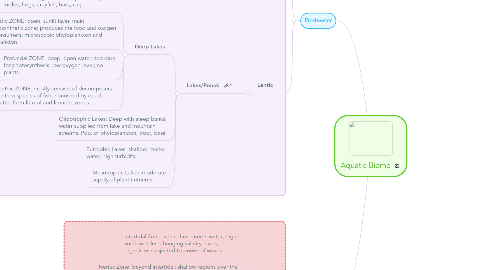
1. Freshwater
1.1. Lotic
1.1.1. Rivers/Streams
1.1.1.1. Currents: stronger with an increase in rainfall. Flow takes place from mountains to the sea.
1.1.1.1.1. Zones
1.2. Lentic
1.2.1. Lakes/Ponds
1.2.1.1. Deep Lakes
1.2.1.1.1. Littoral ZONE : top layer near shore; shallow sunlit waters; high biodiversity; rooted plants, turtles, frogs, crayfish, bass, carp.
1.2.1.1.2. Limnetic ZONE: open, sunlit layer. main photosynthetic zone; produces the food and oxygen for consumers; microscopic phytoplankton and zooplankton.
1.2.1.1.3. Profundal ZONE: deep, open water; too dark for photosynthesis; low oxygen level; no plants
1.2.1.1.4. Benthic ZONE: mostly consists of decomposers; benthos species of fish; nourished by dead matter from littoral and limnetic zones.
1.2.1.2. Oligotrophic Lakes: Deep with steep banks; water supplied from lake and mountain streams. Pop. of phytoplankton, trout, bass
1.2.1.3. Eutrophic Lakes: shallow, murky water, high turbidity
1.2.1.4. Mesotrophic Lakes: moderate supply of plant nutrients.
2. Saltwater
2.1. Photic
2.1.1. Intertidal Zone: where land meets water; high and low tides; changing salinity levels; organisms subjected to power of waves
2.1.2. Neritic Zone: beyond intertidal; shallow regions over the continental shelves in warm tropical waters; contains coral reefs; constant renewal of nutrients; photosynthesis
2.1.3. Oceanic Pelagic Zone: extends past continental shelves, can be very deep; open water; most of the ocean’s water; water mixed by ocean currents; plankton (fish, large squid, sea turtles, marine mammals ). (can be found in photic and aphotic zone)
2.2. Aphotic
2.2.1. Benthic Zone: ocean bottom below neritic and oceanic pelagic zones; temperature determine community development; nutrients "rain" down from above in form of detritus; communities consist of bacteria, fungi, seaweed, algae, invertebrates, and fish.
